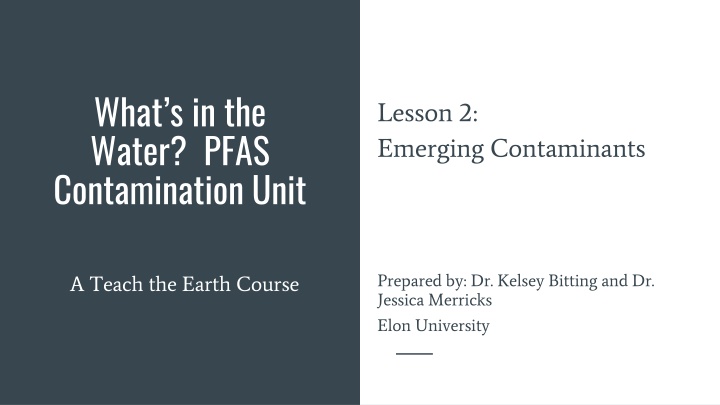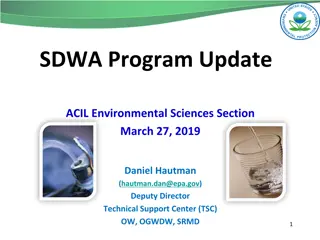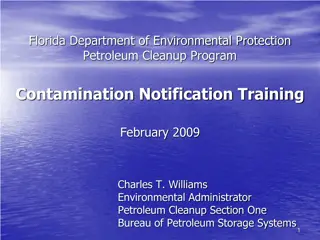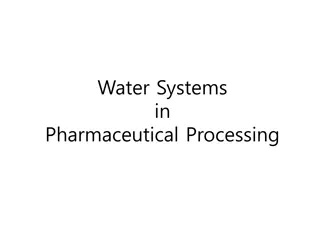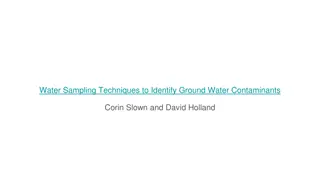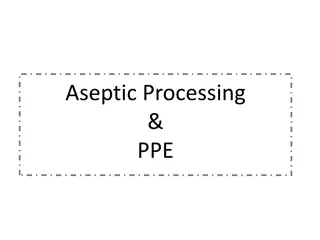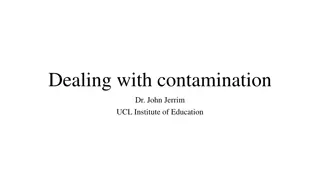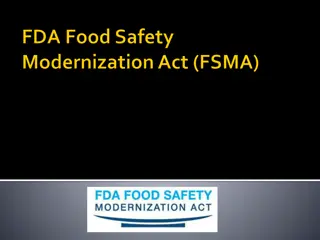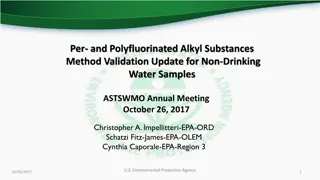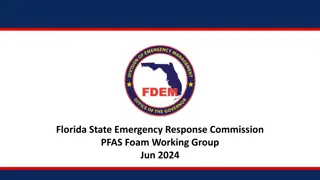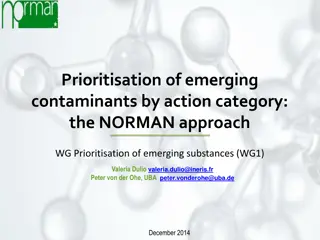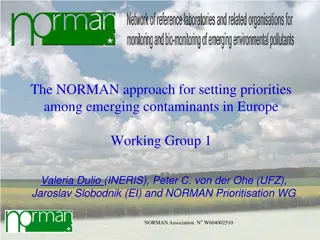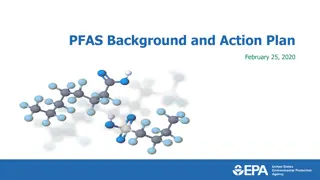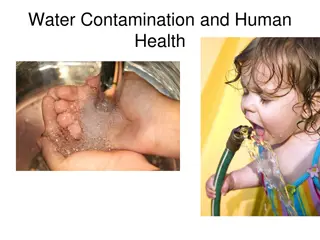PFAS Contamination in Water: Emerging Contaminants Lesson
This lesson delves into the concerns surrounding PFAS contaminants in water sources. Explore the origins, composition, and lifecycle of PFAS chemicals, along with discussions on emerging vs. established contaminants. Discover the impact on human health, wildlife, and government regulations, and engage in activities to understand and uncover common emerging contaminants.
Download Presentation

Please find below an Image/Link to download the presentation.
The content on the website is provided AS IS for your information and personal use only. It may not be sold, licensed, or shared on other websites without obtaining consent from the author.If you encounter any issues during the download, it is possible that the publisher has removed the file from their server.
You are allowed to download the files provided on this website for personal or commercial use, subject to the condition that they are used lawfully. All files are the property of their respective owners.
The content on the website is provided AS IS for your information and personal use only. It may not be sold, licensed, or shared on other websites without obtaining consent from the author.
E N D
Presentation Transcript
Whats in the Water? PFAS Contamination Unit Lesson 2: Emerging Contaminants Prepared by: Dr. Kelsey Bitting and Dr. Jessica Merricks Elon University A Teach the Earth Course
Agenda Activity 1: Emerging vs. established contaminants Mini-lecture: PFAS origins and structure Activity 2: PFAS and the Urban Water Cycle Wrap-up and Homework
Learning Objectives Define emerging contaminant in the context of drinking water Discuss the origins, general chemical composition, and life cycle of the PFAS family of chemicals
Big Picture Questions What are emerging contaminants? What is the PFAS family of chemicals and why are they a concern?
Activity 1- Understanding Emerging Contaminants Explore your assigned contaminant pair in your small group. Use the T-chart to describe the following: Source(s) Prevalence (common geographic regions, concentrations, etc.) Known effects on wildlife Known effects on human health Government regulation
Activity 1- Uncovering Emerging Contaminants Emerging Contaminants Common Contaminants
Activity 1- Uncovering Emerging Contaminants Emerging Contaminants Common Contaminants Fluoride Nitrate Lead Arsenic Mercury Copper Ammonia Uranium Nanomaterials Polybrominated biphenols Phenytoin Meprobamate Linuron DNT Perchlorate 1,4-dioxane
What are emerging contaminants? Chemicals whose effects are not yet well understood Many are chemically-engineered (not found in nature) Some are natural but their concentrations have been increased by human activity Suggestion: Figure 1.1 from Day et al., 2019 Saptarshi Dey, Farhat Bano, Anushree Malik, 1- Pharmaceuticals and personal care product (PPCP) contamination a global discharge inventory. Editor(s): Majeti Narasimha Vara Prasad, Meththika Vithanage, Atya Kapley, Pharmaceuticals and Personal Care Products: Waste Management and Treatment Technology, Butterworth-Heinemann, 2019, Pages 1-26. Instructors should include a figure/diagram here to illustrate the various types of emerging contaminats.
What concerns are related to emerging contaminants? Alteration of the microbiome, inc. the human microbiome Antimicrobial resistance Endocrine disruption (infertility, feminization, other hormonal disruption) Oxidative stress Cancer and lesions General toxicity to humans and other organisms (Gogoi et al., 2018; Chaturvedi et al., 2021)
What are PFAS? Negatively-charged, water-soluble compounds Hydrophobic ( water-fearing ) end made of carbon and fluorine Hydrophylic ( water-loving ) functional group end including oxygen and hydrogen Instructors should include a figure/diagram here to illustrate the chemical structure of PFAS compounds Suggestion 1: Image of chemical structure of PFAS from https://www.niehs.nih.gov/health/topics/agents/pfc/index.cfm Suggestion 2: Image of PFOA and PFOS compared to GenX chemical structure from https://yourscvwater.com/pfas/
Instructors should include a figure showing a general timeline of PFAS discovery and use Suggestion: https://www.kimley-horn.com/what-is-pfas/ Water- and grease-resistant properties
Why forever chemicals? Carbon-fluorine bond is the 4th strongest single bond in organic (carbon-based) chemistry Polar-covalent bond (Fl and C share electron pairs) Partial ionic character due to charges (Fl has a negative charge, C has a positive charge, so they attract) Extremely non-reactive and stable Instructors should include a figure/diagram here to illustrate the chemical structure of PFAS compounds Suggestions on Slide 13
Instructors should include a map or diagram showing how PFAS moves through the environment here. Suggestion: image on page 8 of https://www.awwa.org/Portals/0/AWWA/ETS/Resources/15683PFAS_web.pdf
Activity 2 - The PFAS Life Cycle and Urban Water Cycle For your assigned PFAS source, address the following questions: Where might this source of PFAS go from its initial source? What pathways might it follow to contaminate soils, surface water, groundwater, air, or other natural resources? How might that pathway eventually lead to PFAS ingestion by humans? Pets? Other animals? Create a sketch of your pathways, take a picture, and add it to your slide
Emerging Contaminants in the Environment Instructors should include a map or diagram showing how contaminants move through the environment Suggestion: image linked here: https://toxics.usgs.gov/regional/emc/transport_fate.html
Closing questions If PFAS is everywhere, is Pittsboro s especially problematic? What about all those other emerging contaminants? POV Statements: write a statement from the point a Pittsboro resident based on what you know so far. You could write a reflection expressing your feelings about the water issue (what bothers you the most), your concerns about yourself and others in the community, or something else. In your opinion, what should happen next?
